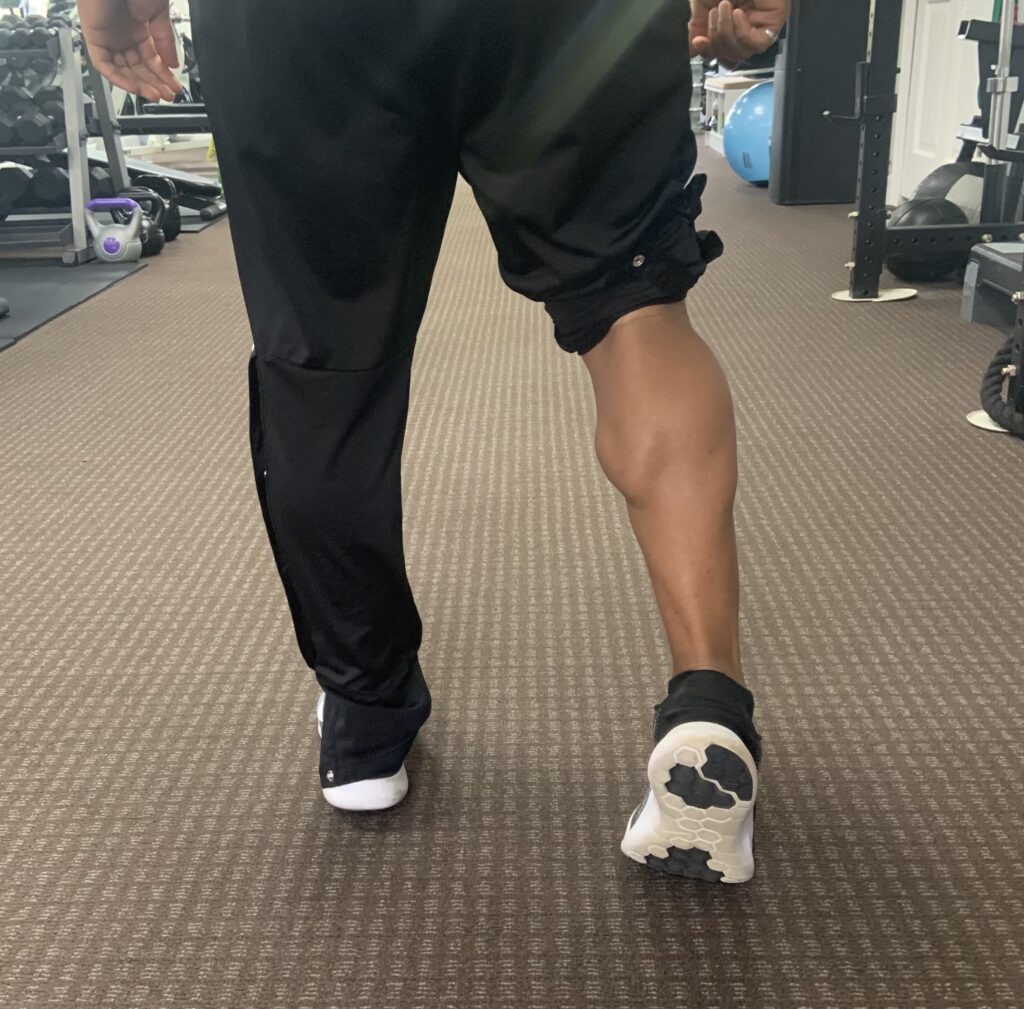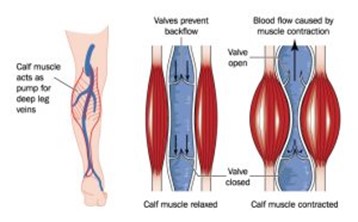Why Is the Calf Muscle Considered the Second Heart?
from: Amanda Garcia at Healthtide.com

The calf muscle is often considered the second heart because it plays a role within the circulatory system that is similar to the heart. One pump of the heart exerts enough power to send blood throughout the body, reaching the lower extremities in just seconds. That oxygen-rich blood flows through arteries and capillaries to reach every cell of the body, providing oxygen and nourishment.
The oxygen-depleted blood then needs to travel back up through veins to reach the heart, where it will pass into the lungs to receive a replenishing supply of oxygen. The problem is that traveling back up to the heart takes more force than a single pump of the heart can provide because the blood is flowing counter to gravity. To get the job done efficiently, the veins need negative energy from the pumping heart plus stimulation from what is now known as the “calf muscle pump.”
Once you learn how the calf muscle assists the heart in circulating blood throughout your body, you’ll understand why keeping your calves strong is just as important as protecting your heart through good nutrition, exercise and other healthy lifestyle choices.
How the Calf Muscle Pump Works

Venous return refers to oxygen-depleted blood returning to the heart from the legs and feet. Since the heart can’t do it alone, veno-muscular pumps in the lower body apply upward pressure on the veins to keep it moving at an efficient pace and in the right direction. These pumps include the ankle pump and the calf muscle pump, and they work together in the following process:
- The foot pump initiates venous return. This occurs each time you take a step. When your heel touches down, blood is pooled in the veins. When the front of your foot touches down, that pooled blood is discharged upwards.
- The discharged blood enters veins in the soleus muscle. This muscle extends from the ankle to the back of the knee and contains critical veins responsible for passing oxygen-depleted blood through the lower legs to the knee, which serves as a meeting point for veins in the lower leg. Each time this calf muscle contracts, it applies pressure to the veins. That pressure is what fuels venous return.
- The blood is transferred into veins running between the knee and the groin. From there, it enters the abdominal cavity and travels through the vena cava to the heart. There is less resistance from gravity on this final leg of the trip.
The network of veins in the lower leg is extensive, so the process of venous return is a bit more complex than described in these steps. This network includes veins of different sizes and of different depths, and they all feed into one another to get the blood back to the heart as quickly as possible.
They work as a team, but none of them can do their job well without a strong calf muscle pump. When the ankle and soleus muscle are strong and in proper working order, they form your peripheral heart and pump the blood consistently upward to prevent varicose and spider veins.
Limitations of the Calf Muscle Pump
Veins in the lower body have one-way valves that stop the blood from moving back toward the feet when the calf muscles aren’t active. This is the body’s natural way of combatting the biggest limitation of the calf muscle pump: inactivity.
When you stop moving your legs, you stop applying that upward pressure to stimulate venous return. Your heart will naturally apply some pressure to those veins, but the rate of blood flow through the lower legs slows down dramatically. If your calves are inactive for long periods of time, your blood is at greater risk of pooling in the veins. This puts you at risk for developing spider veins, varicose veins and blood clots.
If those one-way venous valves become weak or inefficient, you can develop a condition known as venous insufficiency. This occurs when blood flows backwards and pools in the lower legs, which can lead to swelling, pain, cramping and ulcers. This condition is also connected to deep vein thrombosis, which is a blood clot in the deep veins of the lower legs. That clot may travel upwards and become a serious health risk.
You’re at greater risk of developing venous insufficiency if your lifestyle is sedentary or you spend long periods of time standing. If you’re overweight or obese, your risk goes up even higher.
How to Protect Your Calf Muscles
One study published in the Journal of Biomechanicsin November of 2014 found that men and women with chronic heart failure have smaller calf muscles than healthy people with fully functional hearts. These smaller muscles must work harder to keep venous return flowing properly, and the ankles work harder as well. This leads to overexertion during exercise, which is presented as exhaustion and poor performance.
Small calf muscles are the result of muscle atrophy. This happens naturally with age, but it’s accelerated for people with a sedentary lifestyle. The less you use your calf muscles, the more they are going to shrink. The more they shrink, the harder they have to work to push blood through your veins and the greater your risk for heart disease.
Muscle atrophy in the calves can also occur due to nutritional deficiencies, so diet is just as important as calf-strengthening exercise. You’re also at greater risk of venous insufficiency if you’re overweight, and diet plays a critical role in maintaining a healthy body weight. Consuming a well-balanced diet rich in nutrients should help correct your weight while delivering the nutrients that your calves need to remain strong and efficient.
It may seem too simplistic to say that a strong, efficient calf muscle pump comes down to exercise and nutrition, but it really is that simple. If you can keep your soleus muscles strong and well-nourished, you can help your heart by improving the flow of deoxygenated blood from your lower extremities. This has a powerful impact on your overall health and wellbeing, so it’s time to lace up the sneakers and get moving.
Calf-Strengthening Exercises
Believe it or not, one of the best things that you can do for your calves is walk. As we discussed how the calf muscle pump works above, we were basically describing a walking motion. Each time your foot hits the ground, the calf muscles are activated and the veins are stimulated for healthy venous return.
Start by improving your overall daily activity level so that you don’t sit or stand still for long periods of time. Make a new rule that you get up for at least five minutes every hour if you have to remain sedentary for work or other activities. You may also make an effort to go for mini walks throughout the day to keep those soleus muscles – and your blood – pumping.
What can you do during those five-minute breaks to fire up your calves? The following calf-strengthening exercises are good options:
- Calf Raises – This is a simple movement that you can do throughout the day in any location. Stand with your feet together or slightly apart and raise your heels so that you’re standing on the balls of your feet. Lower your heels, and then lift them up again. Continue lifting and lowering for at least 10 repetitions. You can also do this move on the edge of a step to make it a bit harder, or do it from a sitting position if you want to keep your calves active while watching television or working.
- Lunges – Stand with your feet about hip-width apart. Place your hands on your waist or raise your arms out to your sides for balance as you bring one foot forward, placing it firmly on the ground one step in front of your body. Keeping your upper body stable, bend your knees to lower your back knee toward the ground. Raise back up to standing and use your front leg to push back to your beginning position. Rotate legs while standing in the same spot or do walking lunges if you want to move around.
- Toe Walks – Raise up on your toes and walk around the room for 60 seconds. You can start with less time and build up if your calf muscles aren’t currently strong enough. If you do have strong calf muscles, hold dumbbells or kettlebells at your side as you walk around the room.
- Foot Pumps – You can do this calf-strengthening exercise while lying in bed, watching television or sitting at your desk. Your feet are likely more flexible without shoes, but you can do this with shoes if needed. Start by pointing your toes to flex your foot forward. Then pull your toes back as far as possible, pointing up toward the ceiling or your knees for a backwards flex. Continue rotating between a strong point and flex.
It’s also important to stretch your calves to keep your soleus muscle flexible and efficient. If it becomes too tight, it won’t stimulate your veins efficiently and will feel uncomfortable. Some of the best calf stretches are also great for improving flexibility in the ankles, which will keep your ankle pump working efficiently as well.
One simple calf stretch that is also great for your ankles utilizes a workout band or long towel. Sit on the floor with one leg stretched out in front of you. Wrap the towel or band around the bottom of your foot, holding the ends and gently pulling toward your upper body. This will force your foot to flex back, lifting your heel from the ground. You will feel a light stretch through your calf when the foot is flexed back far enough.
